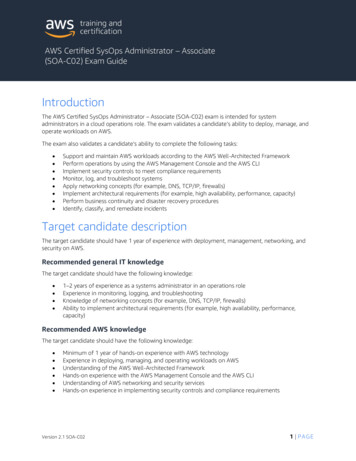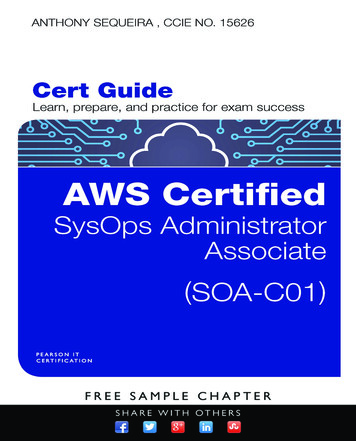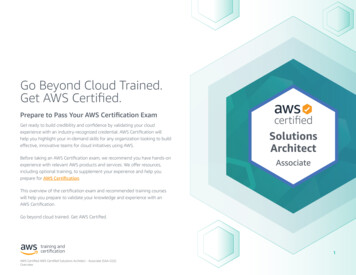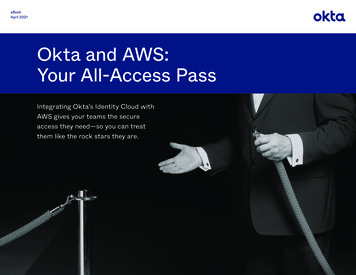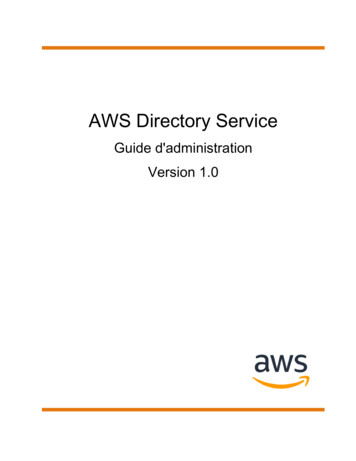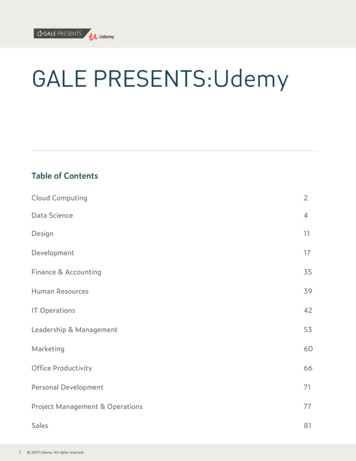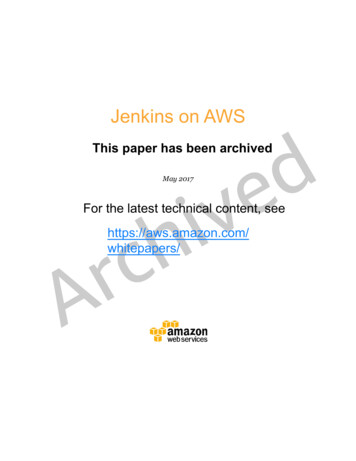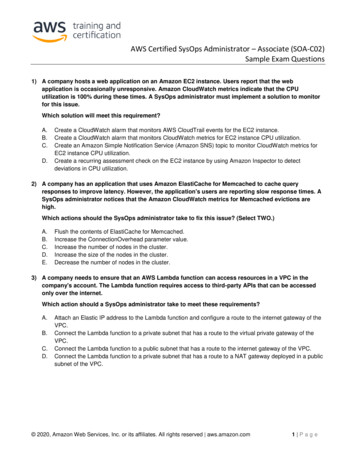
Transcription
AWS Certified SysOps Administrator – Associate (SOA-C02)Sample Exam Questions1) A company hosts a web application on an Amazon EC2 instance. Users report that the webapplication is occasionally unresponsive. Amazon CloudWatch metrics indicate that the CPUutilization is 100% during these times. A SysOps administrator must implement a solution to monitorfor this issue.Which solution will meet this requirement?A.B.C.D.Create a CloudWatch alarm that monitors AWS CloudTrail events for the EC2 instance.Create a CloudWatch alarm that monitors CloudWatch metrics for EC2 instance CPU utilization.Create an Amazon Simple Notification Service (Amazon SNS) topic to monitor CloudWatch metrics forEC2 instance CPU utilization.Create a recurring assessment check on the EC2 instance by using Amazon Inspector to detectdeviations in CPU utilization.2) A company has an application that uses Amazon ElastiCache for Memcached to cache queryresponses to improve latency. However, the application's users are reporting slow response times. ASysOps administrator notices that the Amazon CloudWatch metrics for Memcached evictions arehigh.Which actions should the SysOps administrator take to fix this issue? (Select TWO.)A.B.C.D.E.Flush the contents of ElastiCache for Memcached.Increase the ConnectionOverhead parameter value.Increase the number of nodes in the cluster.Increase the size of the nodes in the cluster.Decrease the number of nodes in the cluster.3) A company needs to ensure that an AWS Lambda function can access resources in a VPC in thecompany's account. The Lambda function requires access to third-party APIs that can be accessedonly over the internet.Which action should a SysOps administrator take to meet these requirements?A.B.C.D.Attach an Elastic IP address to the Lambda function and configure a route to the internet gateway of theVPC.Connect the Lambda function to a private subnet that has a route to the virtual private gateway of theVPC.Connect the Lambda function to a public subnet that has a route to the internet gateway of the VPC.Connect the Lambda function to a private subnet that has a route to a NAT gateway deployed in a publicsubnet of the VPC. 2020, Amazon Web Services, Inc. or its affiliates. All rights reserved aws.amazon.com1 Page
AWS Certified SysOps Administrator – Associate (SOA-C02)Sample Exam Questions4) A company runs an application on a large fleet of Amazon EC2 instances to process financialtransactions. The EC2 instances share data by using an Amazon Elastic File System (Amazon EFS)file system.The company wants to deploy the application to a new Availability Zone and has created new subnetsand a mount target in the new Availability Zone. When a SysOps administrator launches new EC2instances in the new subnets, the EC2 instances are unable to mount the file system.Which of the following is a possible reason for this issue?A. The EFS mount target has been created in a private subnet.B. The IAM role that is associated with the EC2 instances does not allow the efs:MountFileSystem action.C. The route tables have not been configured to route traffic to a VPC endpoint for Amazon EFS in the newAvailability Zone.D. The security group for the mount target does not allow inbound NFS connections from the security groupused by the EC2 instances.5) A company uses AWS Organizations to create and manage many AWS accounts. The company wantsto deploy new IAM roles in each account.How could a SysOps administrator deploy the new roles in each of the organization's accounts?A. Create a service control policy (SCP) in the organization to add the new IAM roles to each account.B. Deploy an AWS CloudFormation change set to the organization with a template to create the new IAMroles.C. Use AWS CloudFormation StackSets to deploy a template to each account to create the new IAM roles.D. Use AWS Config to create an organization rule to add the new IAM roles to each account. 2020, Amazon Web Services, Inc. or its affiliates. All rights reserved aws.amazon.com2 Page
AWS Certified SysOps Administrator – Associate (SOA-C02)Sample Exam Questions6) A company runs several production workloads on Amazon EC2 instances. A SysOps administratordiscovered that a production EC2 instance failed a system health check. The SysOps administratorrecovered the instance manually.The SysOps administrator wants to automate the recovery task of EC2 instances and receivenotifications whenever a system health check fails. Detailed monitoring is activated for all of thecompany's production EC2 instances.Which of the following is the MOST operationally efficient solution that meets these requirements?A. For each production EC2 instance, create an Amazon CloudWatch alarm for Status Check Failed:System. Set the alarm action to recover the EC2 instance. Configure the alarm notification to bepublished to an Amazon Simple Notification Service (Amazon SNS) topic.B. On each production EC2 instance, create a script that monitors the system health by sending a heartbeatnotification every minute to a central monitoring server. If an EC2 instance fails to send a heartbeat, run ascript on the monitoring server to stop and start the EC2 instance and to publish a notification to anAmazon Simple Notification Service (Amazon SNS) topic.C. On each production EC2 instance, create a script that sends network pings to a highly available endpointby way of a cron job. If the script detects a network response timeout, invoke a command to reboot theEC2 instance.D. On each production EC2 instance, configure an Amazon CloudWatch agent to collect and send logs to alog group in Amazon CloudWatch Logs. Create a CloudWatch alarm that is based on a metric filter thattracks errors. Configure the alarm to invoke an AWS Lambda function to reboot the EC2 instance andsend a notification email.7) The company uses AWS Organizations to manage its accounts. For the production account, aSysOps administrator must ensure that all data is backed up daily for all current and future AmazonEC2 instances and Amazon Elastic File System (Amazon EFS) file systems. Backups must be retainedfor 30 days.Which solution will meet these requirements with the LEAST amount of effort?A. Create a backup plan in AWS Backup. Assign resources by resource ID, selecting all existing EC2 andEFS resources that are running in the account. Edit the backup plan daily to include any new resources.Schedule the backup plan to run every day with a lifecycle policy to expire backups after 30 days.B. Create a backup plan in AWS Backup. Assign resources by tags. Ensure that all existing EC2 and EFSresources are tagged correctly. Apply a service control policy (SCP) for the production account OU thatprevents instance and file system creation unless the correct tags are applied. Schedule the backup planto run every day with a lifecycle policy to expire backups after 30 days.C. Create a lifecycle policy in Amazon Data Lifecycle Manager (Amazon DLM). Assign all resources byresource ID, selecting all existing EC2 and EFS resources that are running in the account. Edit thelifecycle policy daily to include any new resources. Schedule the lifecycle policy to create snapshots everyday with a retention period of 30 days.D. Create a lifecycle policy in Amazon Data Lifecycle Manager (Amazon DLM). Assign all resources by tags.Ensure that all existing EC2 and EFS resources are tagged correctly. Apply a service control policy (SCP)that prevents resource creation unless the correct tags are applied. Schedule the lifecycle policy to createsnapshots every day with a retention period of 30 days. 2020, Amazon Web Services, Inc. or its affiliates. All rights reserved aws.amazon.com3 Page
AWS Certified SysOps Administrator – Associate (SOA-C02)Sample Exam Questions8) A company is using AWS CloudTrail and wants to ensure that SysOps administrators can easily verifythat the log files have not been deleted or changed.Which action should a SysOps administrator take to meet this requirement?A. Grant administrators access to the AWS Key Management Service (AWS KMS) key used to encrypt thelog files.B. Enable CloudTrail log file integrity validation when the trail is created or updated.C. Turn on Amazon S3 server access logging for the bucket storing the log files.D. Configure the S3 bucket to replicate the log files to another bucket.9) A company is running a custom database on an Amazon EC2 instance. The database stores its dataon an Amazon Elastic Block Store (Amazon EBS) volume. A SysOps administrator must set up abackup strategy for the EBS volume.What should the SysOps administrator do to meet this requirement?A. Create an Amazon CloudWatch alarm for the VolumeIdleTime metric with an action to take a snapshot ofthe EBS volume.B. Create a pipeline in AWS Data Pipeline to take a snapshot of the EBS volume on a recurring schedule.C. Create an Amazon Data Lifecycle Manager (Amazon DLM) policy to take a snapshot of the EBS volumeon a recurring schedule.D. Create an AWS DataSync task to take a snapshot of the EBS volume on a recurring schedule.10) A company runs a large number of Amazon EC2 instances for internal departments. The companyneeds to track the costs of its existing AWS resources by department.What should a SysOps administrator do to meet this requirement?A. Activate all of the AWS generated cost allocation tags for the account.B. Apply user-defined tags to the instances through Tag Editor. Activate these tags for cost allocation.C. Schedule an AWS Lambda function to run the AWS Pricing Calculator for EC2 usage on a recurringschedule.D. Use the AWS Trusted Advisor dashboard to export EC2 cost reports. 2020, Amazon Web Services, Inc. or its affiliates. All rights reserved aws.amazon.com4 Page
AWS Certified SysOps Administrator – Associate (SOA-C02)Sample Exam Questions11) Sample Exam LabA company is deploying a new web application. Configure a highly available MySQL 8.0 database with thefollowing:1. Create a custom DB parameter group and set the event scheduler parameter to true and use thisparameter during DB instance creation.2. Create a custom AWS Key Management Service (AWS KMS) key and use this key during DB instancecreation.3. Create a VPC security group that allows TCP port 3306 from the CIDR block 192.168.1.0/24. Use thissecurity group during DB instance creation.4. Launch the Amazon RDS DB instance.5. After launch, take a manual RDS DB snapshot.Provide the snapshot Amazon Resource Name (ARN):Note: Below is a screenshot of how this sample exam lab would appear during the exam. 2020, Amazon Web Services, Inc. or its affiliates. All rights reserved aws.amazon.com5 Page
AWS Certified SysOps Administrator – Associate (SOA-C02)Sample Exam QuestionsAnswers1) B — Amazon CloudWatch provides you with data and actionable insights to monitor your applications.Amazon EC2 sends metrics to CloudWatch. The CPUUtilization metric represents the percentage ofallocated EC2 compute units that are currently in use on an instance. You can create a CloudWatchalarm that monitors CPUUtilization for one of your instances. For example, you might want to receive anemail notification when the average CPUUtilization over a 5-minute period is greater than 75%.2) C, D — The Evictions metric for Amazon ElastiCache for Memcached represents the number of nonexpired items that the cache evicted to provide space for new items. If you are experiencing evictions withyour cluster, it is usually a sign that you need to scale up (use a node that has a larger memory footprint)or scale out (add additional nodes to the cluster) to accommodate the additional data.3) D — By default, AWS Lambda runs your functions in a secure VPC with access to AWS services and theinternet. Lambda owns this VPC, which is not connected to your account's default VPC. When youconnect a Lambda function to a VPC in your account to access private resources, the function cannotaccess the internet unless your VPC provides access. Internet access from a private subnet requiresnetwork address translation (NAT). To give your function access to the internet, route outbound traffic to aNAT gateway in a public subnet.4) D — The security groups that you associate with a mount target must allow inbound access for the TCPprotocol on the NFS port from the security group used by the instances.5) C — With AWS CloudFormation StackSets, you can create, update, or delete stacks across multipleaccounts and AWS Regions with a single operation. A user in the AWS Organizations managementaccount can create a stack set with service-managed permissions that deploys stack instances toaccounts in the organization or in specific organizational units (OUs). For example, you can use AWSCloudFormation StackSets to deploy your centralized IAM roles to all accounts in your organization.6) A — You can use Amazon CloudWatch alarm actions to create alarms that automatically stop, terminate,reboot, or recover your Amazon EC2 instances. For example, if an instance becomes impaired due tohardware or software issues on the physical host, loss of network connectivity, or loss of system power,you can automatically initiate a recovery action to migrate the instance to new hardware. You also canconfigure a message to be published to an Amazon Simple Notification Service (Amazon SNS) topic toreceive a notification of the recovery action.7) B — AWS Backup is a fully managed backup service that makes it easy to centralize and automate thebackup of data across AWS services. The use of tags to assign resources is a simple and scalable way toback up multiple resources. Any resources with the tags that you specify are assigned to the backup plan.A tag policy is a type of service control policy (SCP) in AWS Organizations that can help you standardizeand enforce tags across resources in your organization's accounts.8) B — You can validate the integrity of AWS CloudTrail log files and detect whether the log files wereunchanged, modified, or deleted since CloudTrail delivered them to your Amazon S3 bucket. With avalidated log file, you can assert positively that the log file itself has not changed, or that particular usercredentials performed specific API activity. The CloudTrail log file integrity validation process also informs 2020, Amazon Web Services, Inc. or its affiliates. All rights reserved aws.amazon.com6 Page
AWS Certified SysOps Administrator – Associate (SOA-C02)Sample Exam Questionsyou if a log file has been deleted or changed. You gain the insight to assert positively that log files eitherwere delivered or were not delivered to your account during a given period of time. You can activate logfile integrity validation with the CloudTrail console when you create or update a trail.9) C — You can use Amazon Data Lifecycle Manager (Amazon DLM) to automate the creation, retention,and deletion of Amazon Elastic Block Store (Amazon EBS) snapshots. You can create a lifecycle policythat includes specific tags to back up EBS volumes on a specified schedule and for a specified retentionperiod. For example, you can take a snapshot of an EBS volume every day and keep the snapshots for30 days.10) B — User-defined tags are tags that you define, create, and apply to resources manually. You can useTag Editor to search for all resources and apply tags to them. Use cost allocation tags to track your AWScosts on a detailed level. After you activate cost allocation tags, AWS uses the tags to organize yourresource costs to make it easier for you to categorize and track your AWS costs. For example, to trackcosts by department, you can use a tag that is named "Department" with the value equal to thedepartment name.11) Lab solution:Create a custom DB parameter group and set the event scheduler parameter to true and use thisparameter during DB instance creation.i.Open the Amazon RDS console from https://console.amazonaws.com/rds/.ii.In the Resources section, choose Parameter groups.iii.Choose Create parameter group.iv.In the Parameter group family list, select mysql8.0v.In the Group name box, enter the new DB cluster parameter group name ofmysql80witheventscheduler.vi.In the Description box, enter a description for the new DB cluster parameter group.vii.Choose Create.viii.In the list of parameter groups, check the box next to the parameter group that you want tomodify, which is mysql80witheventscheduler.ix.Choose Parameter group actions and choose Edit.x.In the Filter parameters box, enter event s. This should filter just the event schedulerparameter.xi.Choose the box for the event scheduler parameter. Under Values, change the setting to ON.xii.Choose Save changes.Create a custom AWS Key Management Service (AWS KMS) key and use this key during DBinstance creation.Open the AWS KMS console from https://console.aws.amazon.com/kms.i.In the navigation pane, choose Customer managed keys.ii.Choose Create key.iii.To create a symmetric CMK, for Key type, choose Symmetric.iv.Choose Next.v.Type the alias or display name for the CMK. For this walkthrough, use the value mysqlDbKeyvi.(Optional) Type a description for the CMK.vii.Choose Next.viii.(Optional) To add a tag, click Add tag. Type a tag key and an optional tag value. To add morethan one tag to the CMK, choose Add tag. 2020, Amazon Web Services, Inc. or its affiliates. All rights reserved aws.amazon.com7 Page
AWS Certified SysOps Administrator – Associate (SOA-C02)Sample Exam Questionsix.x.Once completed, choose Next.Select the IAM users and roles that can administer the CMK. For this walkthrough, use your IAMuser.xi.Choose Next.xii.Select the IAM users and roles that can use the CMK for cryptographic operations. For thiswalkthrough, none are needed.xiii.Choose Next.xiv.Review the key policy document that was created from your choices. Note that it can also beedited.xv.Choose Finish to create the CMK.Create a VPC security group that allows TCP port 3306 from the CIDR block 192.168.1.0/24 anduse this security group during DB instance creation.i.Open the Amazon VPC console at https://console.aws.amazon.com/vpc/home.ii.In the navigation pane, choose Security Groups.iii.Choose Create security group.iv.Enter a name for the security group (for example, mysqlAccessGroup) and then provide adescription.v.From VPC, select the ID of your VPC.vi.Under Inbound rules, choose Add rule.vii.Set Type to MYSQL/Aurora.viii.Set Source to My IP.ix.Scroll down and choose Create security group.Launch the Amazon RDS DB instance.i.Open the Amazon RDS console from https://console.aws.amazon.com/rds/.ii.In the navigation pane, choose Databases.iii.Choose Create database.iv.On the Create database page, verify that the Standard create option is chosen. Then chooseMySQL.v.In the Templates section, choose Production.vi.In the DB instance identifier section, type the name mysqldemovii.In the Settings section, set these values:i. Master passwordii. Confirm password – Retype the password.viii.In the DB instance size section, set these values:iii. Burstable classes (includes t classes)iv. db.t3.microix.In the Connectivity section, for Virtual private cloud (VPC), choose an existing VPC.x.Expand the Additional connectivity configuration menu and set these values:v. For Subnet group select the DB subnet group.vi. For Public access, select No.vii. For Existing VPC security groups choose mysqlAccessGroup.xi.Remove the other existing security groups, such as the default security group, by choosing the Xassociated with each.xii.Expand the Additional configuration section.xiii.For the DB parameter group, select mysql80witheventschedulerxiv.For Master key, select mysqlDbKeyxv.Choose Create database to create your RDS MySQL DB instance.After launch, take a manual RDS DB snapshot.i.Open the Amazon RDS console from https://console.aws.amazon.com/rds/.ii.In the navigation pane, choose Databases.iii.In the list of DB instances, choose the DB instance for which you want to take a snapshot. 2020, Amazon Web Services, Inc. or its affiliates. All rights reserved aws.amazon.com8 Page
AWS Certified SysOps Administrator – Associate (SOA-C02)Sample Exam Questionsiv.v.vi.vii.viii.ix.x.Choose Actions and choose Take snapshot.The Take DB snapshot window appears.In the Snapshot name box, type the name of the snapshot. For this walkthrough, usemysqlsnapshot.Choose Take snapshot.From the RDS console, in the navigation pane, choose Snapshots.Choose the snapshot name mysqlsnapshotIn the Details section, note the ARN field and the ARN.Provide the DB snapshot ARN: 2020, Amazon Web Services, Inc. or its affiliates. All rights reserved aws.amazon.com9 Page
A. Grant administrators access to the AWS Key Management Service (AWS KMS) key used to encrypt the . Answers 1) B — Amazon CloudWatch provides you with data and actionable insights to monitor your applications. . Sample Exam Questions. . . . . . to to . . . . . . . AWS Certified SysOps Administrator - Associate (SOA-C02) .

